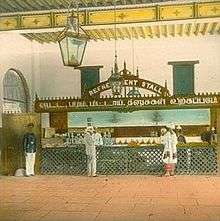Madrasi
Madrasi (Hindustani: मद्रासी (Devanagari), مدراسی (Nastaleeq)) also spelled as Madrassi, is an exonym and frequently used for people and things from Madras (the former name for Chennai before 1996).[1][2][3][4]

Refreshment stall at a railway station in the Madras Presidency, c. 1895
The term of Hindustani origin was originally used by people, mainly around the capital or from other presidencies, in the British Raj to refer to the people of Madras Presidency. The term later started to refer to the entire South Indian region of the post independent India, much of which included the large Madras Presidency of colonial India but also included the unrelated Princely states from this region that joined the republic of India. The use of the term is now outdated.[5]
References
- David Theo Goldberg, Ato Quayson (2002). Relocating Postcolonialism. Wiley-Blackwell. p. 341. ISBN 978-0-631-20805-1.
- Dimitris Eleftheriotis, Gary Needham (2006). Asian Cinemas: A Reader and Guide. University of Hawaii Press. p. 296. ISBN 978-0-8248-3085-4.
- Sri Saibaba s Charters and Sayings -As I Understand. Xlibris Corporation. 2013. p. 176.
- Annette Lynch; Mitchell D. Strauss (2014). Ethnic Dress in the United States: A Cultural Encyclopedia. Rowman & Littlefield. p. 189.
Although “Madras” is the name of a place, in this context it is used as an adjective and not as a proper noun.
- Himadri Banerjee; Nilanjana Gupta; Sipra Mukherjee. Calcutta Mosaic: Essays and Interviews on the Minority Communities of Calcutta. Anthem Press. p. 211.
This article is issued from Wikipedia. The text is licensed under Creative Commons - Attribution - Sharealike. Additional terms may apply for the media files.